Kitchen combined with a balcony: combination rules and design options
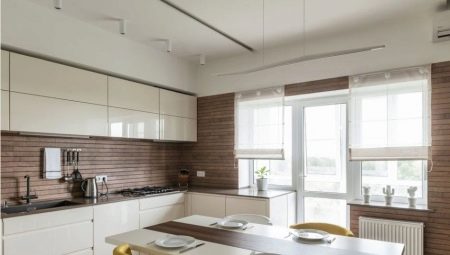
Most of our compatriots cannot boast of an impressive footage of their own apartment. This is a particular problem in the kitchen - the designers half a century ago could not even imagine that there would be anything else here except a stove and a table. Modern owners have to get out in all possible ways, and one of them is to expand the kitchen space onto a balcony or loggia, if they are directly adjacent to each other. Let's say right away - it won't be too cheap, but the effect can exceed all expectations.






Advantages and disadvantages
The problem of a cramped kitchenette, which does not allow not only inviting friends, but even gathering at the dinner table with the whole family, is known by hearsay to all residents of Khrushchev - there is no point in talking about it. At the same time, there are no solutions that would be purely positive - any option can have both pluses and minuses. Since redevelopment will require a considerable amount of money and effort, both should be considered more carefully. A kitchen combined with a balcony or loggia solves the following issues:
- the increase in area is obvious - even a cramped balcony adds 2-3 square meters, and a loggia can give all 6 square meters; this is enough, for example, to move the working area there, which means that it will not take up space in the "main" part of the room;
- you can stand out with the design - at least the kitchen will no longer be a standard cramped box, where everything is predictable; it is original already by the fact of unification as such, and if you also correctly beat it in design, you will get an object of family pride;
- the continuation of the kitchen in the direction of the balcony inevitably increases the illumination of the room - there will be much more light than from a simple window; this allows you to visually increase the area even more, but if there is already enough sunlight, the problem that has arisen will have to be solved with curtains or roller blinds;
- paradoxically, a combined kitchen is usually characterized by improved sound and thermal insulation; it would seem that direct contact with the street should, on the contrary, interfere with this, but it turns out differently - the owners, anticipating such a scenario, are doing everything to reliably isolate the kitchen space from the outside world.






Since we are generally considering the option of combining two premises, it means that such a solution has definitely less disadvantages than advantages.
Nevertheless, it is also worth considering them - suddenly it is the shortcomings that turn out to be decisive in the adoption of the action plan.
- Repair of this scale requires mandatory approval from various authorities, since the question arises of the need for partial dismantling of the outer wall. If you do not pretend to do more than just remove the partition under the former windowsill, then you are unlikely to be prohibited from such a step, but you will have to tinker with the domestic bureaucracy. Taking the risk of experimenting without government permission, at best, you can run into a fine, and at worst, a collapse of a multi-storey building.
- While it is possible to separate from the balcony or loggia with a door, the main circuit of insulation runs precisely along the border of these rooms with the kitchen. Having demolished all the partitions, you will be forced to thoroughly insulate the attached territory, and taking into account the peculiarities of our climate, this will have to be done thoroughly, which will not be affordable for everyone.
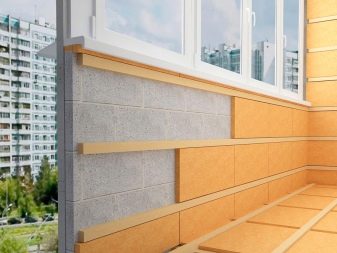

Features of redevelopment
If it is decided that the combination should be, it is necessary at the family council to decide how exactly the kitchen combined with the balcony will look like. The fact is that coordination with the regulatory authorities is possible only with a clear understanding of what you are planning to do - you must explain in detail to the authorities what changes you plan to make, because you will definitely not be given carte blanche for any changes. In general, there are several options for expanding the kitchen with a balcony or loggia.
- Unification without demolishing the window sill. This is the most gentle option, since the only thing that needs to be dismantled is the actual window block with the door. Instead of a window sill, a tabletop is usually installed, which can serve as a comfortable dining area.



- Joining the balcony by completely demolishing the wall. As a result, the owners will receive a truly spacious space, but this is not only expensive, but also not always possible. It is possible to demolish a wall in a panel house only if it is not a carrier, but think for yourself how great such a probability is.



- Removal of a full-fledged working area to the former balcony. This is already an option for those who cannot be forbidden to live beautifully - while others are choosing a kitchen apron, you can instead admire the landscapes opening from the panoramic windows. If we combine the premises in this way, then the permits will have to be obtained much more, and the withdrawal of the necessary communications will cost additional money.
As a rule, in a connected kitchen it is not allowed to take out the drain to the balcony, unless you live on the ground floor.
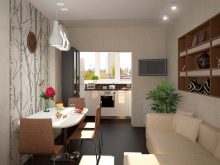


The correct procedure for joining, or rather, documentary obtaining permits, consists of several stages. First you need to build an intelligible project of exactly how you want to attach the balcony to the main part of the kitchen, and submit it to the BTI. If the authority considers that your planned actions will not harm anyone, their permission will have to be additionally certified by the Ministry of Emergency Situations, Sanitary and Epidemiological Services and the ZhEK, which, by the way, may also require from you the documented consent of your neighbors.When the collected folder with documents is ready, it must be submitted for approval by the housing inspectorate, and only it, having issued the final act, will officially allow you to start working.


For those who have read the previous paragraph and realized that it is better to bypass all this bureaucracy, we repeat: this is fraught with, if not a collapse of the building, then a serious fine. You can be a professional builder and be completely confident that your redevelopment does not threaten anyone - it is not recommended to do it without prior agreement with the authorities. Of course, you can hope that the regulatory authorities will never get to your apartment, but, at the very least, when you resell the cunning, it will definitely come out.


Finishing
The repair that you have started will be difficult, but you can no longer retreat halfway - having destroyed the partition, you must complete the project, otherwise you risk getting freezing temperatures in the kitchen and throughout the apartment in winter. The scale of the task is such that it is worth starting in the spring - then everything can be done in time by the fall. NSThe first step is a large-scale re-glazing of the balcony, due to which it was decided to expand the kitchen. Double-glazed windows should be only three-chamber, otherwise thermal insulation cannot be achieved, and there is a risk that the glass will simply be covered with ice. In the same way, it is worth paying attention to the wall partitions of the loggia - sew it up from the outside with siding, thoroughly insulating it with penoplex and penofol, be sure to seal all the cracks.



The kitchen, which passes into the balcony, can easily remain without a heating radiator. - if you decide to demolish the entire wall, keep in mind that it is usually impossible to take out the battery to the former territory of the extension. There are no such restrictions regarding underfloor heating, therefore, the optimal solution for the entire combined room with an area of 10 sq. m will be just such a system.
Contrary to popular belief, such a mechanism does not require an impressive amount of electricity, but it effectively solves the problem of classic heating in apartment buildings, since it warms up the entire room evenly.



Finishing materials are the last to be approached, and you should not forget that your new combined room is still a kitchen, which means that the requirements for finishing remain high. There are not so many options - you need increased wear resistance, the ability to withstand high humidity and temperature, not to absorb dirt and to treat detergents normally.
Laminate, parquet, linoleum or ceramic tiles are suitable for the floor. For walls, there are even fewer suitable solutions - the same tiles, Venetian plaster or wall panels, because wallpaper is undesirable due to the likelihood of fire. The layout of a new space involves a pitfall that many do not think about - everyone wants to enlarge the kitchen, but they forget that in too large a room you often feel uncomfortable. Various ideas with additional furniture help to solve the problem - it is usually recommended to hang the walls with a large number of cabinets, install a countertop on the old partition, and if you have radically demolished it, put a bar counter in the same place.




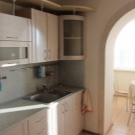

Not quite finishing, but still an interesting solution in the interior is the creation of a so-called winter garden - a greenhouse, figuratively speaking. All that is needed for this is simply to fill the entire former loggia or its predominant part with green spaces. For our conditions, this is an excellent solution, at least in terms of maintaining a positive mood - no matter how bitter the frosts outside the window, at home you will still feel a piece of summer and warmth. By the way, it has been proven that dullness and cold dull appetite, and this is not very good for health, so the option with a winter garden deserves consideration.Among other things, the greenhouse can be used for an extremely practical purpose - after all, no one bothers to grow there not just ornamental plants, but the same fresh onions, parsley or dill.



Another original solution is the so-called French windows.that take up the entire space from floor to ceiling. They are installed in the gap between the kitchen and the balcony, due to which the two rooms are still not fully connected to each other, but at the same time visually they become a single whole, because there are no more barriers to the passage of light.
This finishing option is usually used by those people whose loggia was quite spacious - it is possible to organize a recreation area or even an office on it, while the characteristic kitchen smells will not penetrate there.


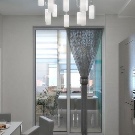


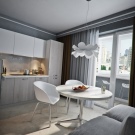
Style selection
By combining the kitchen and the balcony with each other, you have already submitted a minimum application for the originality of your own apartment, but you need to remember that a unique design can turn out to be terrible. After spending huge sums of money on remodeling and subsequent renovations, owners usually want to see some kind of special interior design that matches the best ideas about a certain popular style. First of all, you need to do something with the resulting opening. If this is still possible with a loggia, then the balcony certainly does not repeat the size of the width of the kitchen, so pretending that “it was” simply will not work - you need to figure out how to make a noticeable transition. Most often, its design should fit into the overall interior of the kitchen, and predecessors have even developed minimal recommendations that do not require any imagination. So, a modernist solution requires wavy slopes, a strict modern style assumes the simplest rectangular arch, but the more familiar semicircular arch goes well with the good old classics.

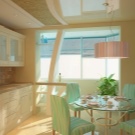




Important! Since the balcony will most likely be used as a separate functional area, zoning (and at the same time the design of the opening) may also suggest differences in floor level. There are no preferable indications as to where the level will be higher, but it is somewhat preferable to raise the floor of the balcony, making a small podium, and even with lighting.
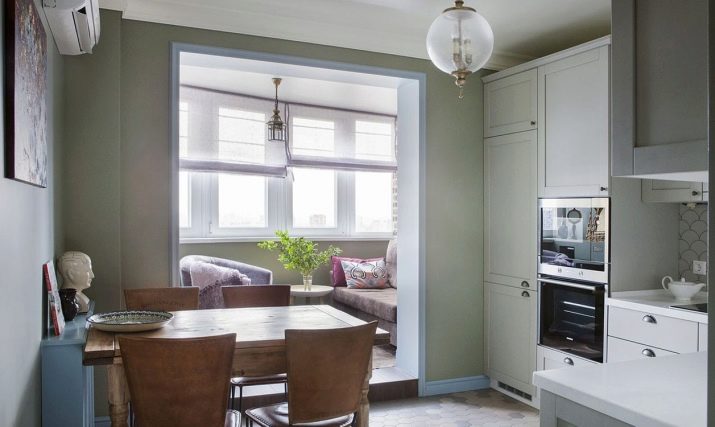

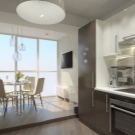



As for the stylistic design of the combined premises, the owners are given the same styles to choose from that are used in the design of "simple" kitchens - that is, almost any. Another thing is that the resulting room turns out to be quite large and a priori suggests zoning, therefore, in recent years, an increasingly popular move here is the combination of several design styles at once. It is not forbidden to experiment, but the experience of previous generations has developed certain stable combinations - for example, hi-tech is “friendly” with minimalism, classics look great with modernity and retro, and Rococo will make a good company for Provence.
If you followed the advice from the previous part of the article and occupied the space of the former balcony with green spaces, Provence-style decoration would be the ideal accompaniment for them.
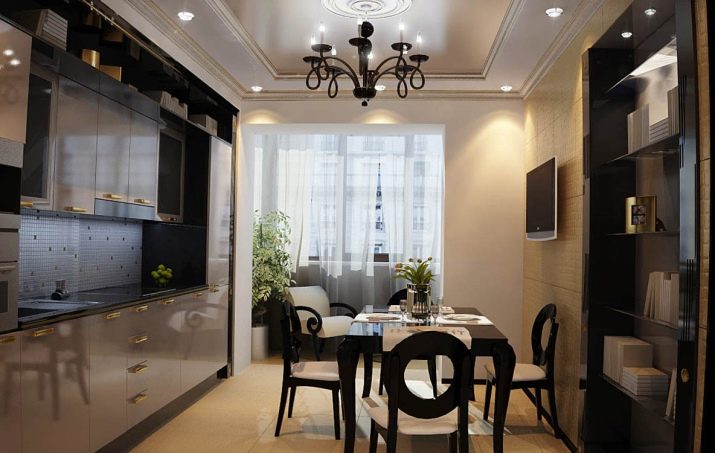

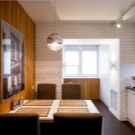



When choosing a style of decoration, pay attention to such an important nuance as the specifics of lighting. Generally accepted design rules suggest that predominantly light shades should be used to visually enlarge a cramped room, which in most cases is a typical kitchen in an apartment building. They are supposedly useful for improving mood, and therefore for improving appetite. By attaching a balcony, your kitchen will no longer be so small, and by improving lighting in a natural way, it will seem even more spacious. This expands your options for using darker shades, but it can limit the use of a light palette if the room risks being too large without it.

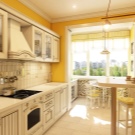




Beautiful examples
It is wrong to discuss a kitchen connected to a balcony without illustrative examples - not all people had the opportunity to observe such a design decision with their own eyes. To get a good idea of what this might look like, let's take a look at a few photos that illustrate the results of the redevelopment.
- Even if you originally had a large balcony, this does not mean that it cannot be combined with the kitchen. As you can see in the first photo, there was so much space that the former balcony became a full-fledged dining area for several people, or, if you prefer, a home cafe, while the window sill was turned into another tabletop for the working area. With such a kitchen-living room, you don't even need a separate living room - guests, if anything, there is where to receive.

- A significant increase in room illumination is demonstrated in the second example. It also shows how this helps to use dark tones in the design. The suite here is dark blue, but it does not create a depressing impression - on the contrary, without it the kitchen would look kind of limitless and uncomfortable. The window sill was used in a completely different way - no table, except for the tabletop in its place, is seen in the frame.

- Since we are talking about a non-standard approach to planning, you can at the same time transfer it to the design. The owners of the apartment from the third example decided to decorate the room in a classic style, and it turned out very old-fashioned - so much so that you just want to gasp with admiration.
Despite the preserved unique feeling of coziness, which cannot be found in kitchens today, the room has not lost its functionality at all.

For information on how you can combine and insulate a balcony with a kitchen, see the next video.








